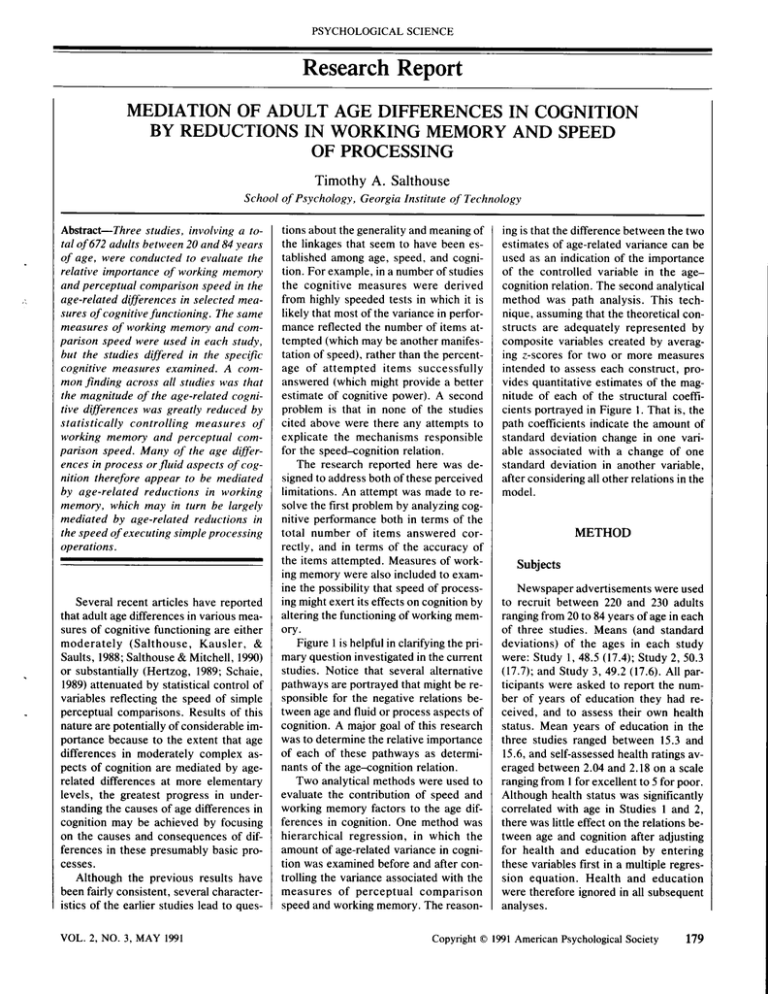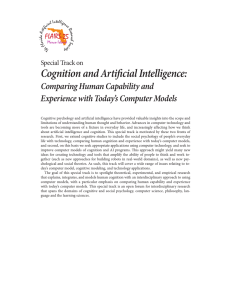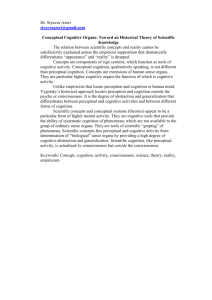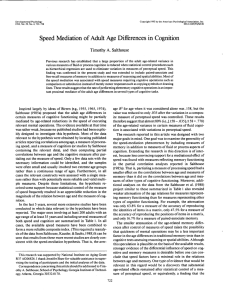Research Report
advertisement

PSYCHOLOGICAL SCIENCE ResearchReport MEDIATION OF ADULT AGE DIFFERENCES IN COGNITION BY REDUCTIONS IN WORKING MEMORY AND SPEED OF PROCESSING Timothy A. Salthouse School of Psychology, Georgia Institute of Technology Abstract-T/rree studies, involving a total of672 adultsbetween20 and 84 years of age, were conductedto evaluatethe relative importance of working memory and perceptualcomparisonspeedin the age-relateddffirences in selectedmeasuresof cognitivefunctioning. The same measuresof working memory and comparison speedwere used in each study, but the studies dffired in the specific cognitive measuresexamined. A common finding across all studies was that the magnitudeof the age-relatedcognitive differences was greatly reduced by statistically controlling measures of working memory and perceptual comparisonspeed.Many of the age dffirencesin process or fluid aspectsof cognition therefore appear to be mediated by age-related reductions in working memory, which may in turn be largely mediated by age-related reductions in the speedof executingsimpleprocessing operations. Severalrecent articles have reported that adult agedifferencesin variousmeasuresof cognitivefunctioningare either m o d e r a t e l y ( S a l t h o u s e ,K a u s l e r , & Saults,1988;Salthouse& Mitchell, 1990) or substantially(Hertzog, 1989;Schaie, 1989)attenuatedby statisticalcontrol of variablesreflectingthe speedof simple perceptualcomparisons.Resultsof this nature are potentially of considerableimportance becauseto the extent that age differences in moderately complex aspects of cognition are mediated by agerelated differences at more elementary levels, the greatest progress in understandingthe causesof agedifferencesin cognition may be achieved by focusing on the causesand consequences of differencesin these presumablybasic processes. Although the previous results have beenfairly consistent,severalcharacteristics of the earlier studies lead to quesvol-.2. NO. 3. MAY l99l tions aboutthe generalityand meaningof the linkagesthat seemto have been establishedamong age, speed,and cognition. For example,in a numberof studies the cognitive measureswere derived from highly speededtests in which it is likely that most of the variancein performancereflectedthe numberof items attempted(which may be anothermanifestation of speed),ratherthan the percenta g e o f a t t e m p t e di t e m s s u c c e s s f u l l y answered(which might provide a better estimateof cognitivepower). A second problem is that in none of the studies cited above were there any attemptsto explicate the mechanismsresponsible for the speed-cognitionrelation. The researchreported here was designedto addressboth oftheseperceived limitations.An attempt was made to resolvethe first problemby analyzingcognitive performanceboth in terms of the total number of items answeredcorrectly, and in terms of the accuracyof the items attempted.Measuresof working memory were also includedto examine the possibilitythat speedof processing might exert its effectson cognitionby alteringthe functioningof working memory. Figure I is helpful in clarifying the primary questioninvestigatedin the current studies. Notice that several alternative pathwaysare portrayed that might be responsiblefor the negativerelations betweenageand fluid or processaspectsof cognition.A major goal of this research was to determinethe relative importance of each of these pathways as determinants of the age-cognitionrelation. Two analyticalmethodswere usedto evaluate the contribution of speed and working memory factors to the age differencesin cognition. One method was hierarchical regression,in which the amount of age-relatedvariance in cognition was examined before and after controlling the variance associatedwith the measures of perceptual comparison speedand working memory. The reason- ing is that the differencebetweenthe two estimatesof age-relatedvariancecan be used as an indication of the importance of the controlled variable in the agecognitionrelation.The secondanalytical method was path analysis.This technique,assumingthat the theoreticalconstructs are adequately representedby compositevariablescreatedby averaging z-scoresfor two or more measures intendedto assesseach construct, provides quantitativeestimatesof the magnitude of each of the structural coefficientsportrayedin Figure l. That is, the path coefficientsindicatethe amount of standarddeviationchangein one variable associatedwith a change of one standarddeviation in another variable, after consideringall other relationsin the model. METHOD Subjects Newspaperadvertisements were used to recruit between 220 and 230 adults rangingfrom 20 to 84 years of agein each of three studies. Means (and standard deviations) of the ages in each study ; t u d y2 , 5 0 . 3 w e r e :S t u d yl , 4 8 . 5 ( 1 7 . 4 )S (17.7);and Study3, 49.2(17.6).All participants were asked to report the number of years of education they had received, and to assesstheir own health status. Mean years of educationin the three studies ranged between 15.3 and 15.6,and self-assessed healthratingsaveragedbetween2.04 and 2.18on a scale rangingfrom I for excellentto 5 for poor. Although health status was significantly correlated with age in Studies I and 2, there was little effect on the relations between age and cognition after adjusting for health and education by entering these variables f,rrstin a multiple regression equation. Health and education were therefore ignored in all subsequent analyses. Copyright O l9l American PsychologicalSociety 179 PSYCHOLOGICAL SCIENCE Mediation of Age Differences presented,followed by a questionasking about relations between terms described in the premises (similar to Salthouse, Mitchell, Skovronek,& Babcock, 1989); paperfolding,in which displaysof one to three successivefolds of paper were illustrated, followed by a representation ofa hole punchedthroughthe folded paper and a patternofholes in an unfolded paper (also similar to Salthouseet al., 1989);cube assembly,in which the six squarescomprising a cube were displayed, and the task was to decide whether arrows in two of the squares would touch if the squareswere assembled into a cube (similar to Shepard& Feng, 1972);and geometricanalogies,in which one to three geometric symbols 6 were displayedin each of four squares, and the task was to decide if the transFig. 1. Path diagram illustrating hypothesizedrelationsamong adult age, speedof formations carried out from the first to processing,working memory, and fluid or processaspectsof cognition. the second squareswere identical to those carried out from the third to the fourth squares(similar to Mulholland, formationwas the last word in each sen- Pellegrino,& Glaser, 1980).Three levels Procedure tence. In both tasks, three trials each of complexity were createdin each task The tasksusedto measureperceptual were presentedwith sequences of one to by varyingthe numberof premisesin the comparisonspeedand working memory sevenarithmeticproblemsor sentences. reasoningtask, the number of folds in were identicalto thoseusedin Study2 of Spans were determined by the largest the paper-folding task, the number of Salthouseand Babcock (1990).Compar- number of items recalledin the correct folds required to assemblethe cube in ison speed was measured with paper- sequenceon at leasttwo ofthe three trithe cube assemblytask, and the number a n d - p e n c i l t a s k s r e q u i r i n g S a m e / als, given that the processing(i.e., arithof symbolsper term or squarein the geoDifferent decisionsabout pairs of three, metic or questionsabout sentences)was metric analogiestask. In Study 2, the 24 problemsat each complexity level were six, or nine letters, and about pairs of also performed correctly. This last repatternscomposedof three, six, or nine quirementwas introducedto ensurethat presentedintermixedin a singleset, with line segments.Three separatelytimed the researchparticipantsactuallycarried a 4-min time limit for each task. The 24 (20 sec each) trials were administered out the requestedprocessing.Correla- problemsat each complexity level were with each task, and the numbersof cortions between the two span measures presentedseparatelyin Study 3, with 90 rect responseson each trial were aver- in the current studies ranged from .55 sec allowedfor each complexitylevel in agedto producea singlescorewith each to .63. each task. type (letter or pattern) of comparison. Different measuresof, or methodsof Correlationsbetweenthe letter compar- assessing,cognition were used across ison and pattern comparison scores in the threestudies.Standardpsychometric RESULTS AND DISCUSSION the three studiesof this project ranged tests were used in Study l; the participantsin this studyperformedthe Shipley from .74 to .80. Cognitiveperformancein each study Working memory was assessedwith AbstractionTest (Shipley,1986),and the the Computation Span and Listening Raven'sAdvancedProgressiveMatrices was analyzed both in terms of the total number of correct items, and in terms of Spantasks.Both ofthese tasksrequired Set II (Raven, 1962\with a 20-mintime limit. Both tests are designedto assess the percentageof attempted items anthe research participant to carry out specifiedprocessingwhile also remem- reasoning,with the first containingseries swered correctly, Composite measures of cognitive performance, with both the bering target information. The process- completionitems with different kinds of number-correctand percentage-correct ing in the Computation Span task inmaterials,and the secondcontainingmameasures,were createdby averagingthe volved the solution of auditorily pretrices of geometric hgures, with the exsentedarithmeticproblems, and the toz-scoresfor eachcognitivemeasure(i.e., aminee attempting to select the best alacross two measuresin Study l, and be-rememberedinformation was the last ternative to complete the missing cell. digit in each problem. Processingin the Studies2 and 3 involved four specially acrossfour measuresin both Studies2 Listening Span task involved answering createdpaper-and-pencil cognitivetests. and 3). The two availablemeasuresof questions about auditorily presented The four tests were: Integrativereason- perceptual comparison speed and worksentences,and the to-be-remembered ining. in which one to threepremiseswere ing memory were also converted to z- 180 v o L . 2 . N O . 3 .M A Y t 9 9 l PSYCHOLOGICAL SCIENCE Timothy A. Salthouse scoresand averagedto provide composite measuresofeach ofthese constructs. Results from the hierarchical regression analyseson the composite scores are summarizedin Table l. The three columnswithin each study representthe cumulative R2 for prediction with all variablesup to that step, the increment in R2 associatedwith an addedvariable, and the F ratio evaluatingthe statistical significanceof R2 for the first variable or the increment in R2 for the second or third variable. For example,the entries under Number Correct for Study I indicate that Age was associatedwith 30.5% of the variancein the compositenumbercorrect measure and Speed with 40.4% when each was considered alone. but 44.87oof the variance was accountedfor when Age was enteredinto the equation after Speed.The incrementin R2 associated with Age after controlling Speed is therefore 4.4%. Similarly, 5l.7Vo of the variancewas associatedwith the Working Memory measurealone, increasing to 55.4Vowhen Age was enteredfollowing Working Memory, and so on. The most interestingaspectsof the data in Table I for the current purposes are the valuesof R2 associatedwith age before controlling any other variables, and the values of R2 for ageafter removing the variation associatedwith measuresof speedand working memory. In all cases, the attenuationof the agerelated effects was substantial.with a reduction from nearly 3lVo of ageassociatedvariance to less than 57o. By expressing the final measure as a percentageofthe original measure,it can be inferred that only betweenUVo(i.e., for the percentagecorrect measurein Study l) and slightly more than lSVo(i.e., for the percentagecorrect measurein Study 3 , I - [ . 0 4 5 / . 2 4 6 ) :. 1 8 3 a , nd.l83x 100 : 18.3%)of the total age-relatedeffects on various measuresof cognitive functioning were not mediatedby age-related reductions in working memory and/or simple perceptualcomparisonspeed.It is also apparentin Table I that, as in the studies by Salthouseand Babcock (1990),the age-relateddifferencesin the current measuresof working memory Table 1. Results of hierarchical regression analyses predicting cognitive performance and working memory Study I (n :221) R2 Number Correct Age .305 Speed Age .404 .448 Working Memory Age Incr. R2 Study 2 (n :228) F R2 * 96.31 .169 .044 159.40* 17.20* .227 .238 .517 .554 .037 252.62* 18.70* Speed Working Memory Age .404 .583 .592 .179 .009 Percentage Correct Age .155 Speed Age .2tl .231 Working Memory Age .405 .408 Speed Working Memory Age .2tl .415 .4r5 Working Memory Age .292 Speed Age .354 .404 Incr. R2 Study 3 (n : 223) F R2 Incr. R2 F 45.80* .255 .01I 66.99* 3 .t 6 .343 .380 .037 l2l.9l* 13.14* .117 .193 .076 32.53* 21.23* .r84 .305 .t2l 58.36x 3 8 . 3*1 214.97* 95.46* 4.73 .227 .232 .241 .005 .009 67.00* 1.62 2.58 .343 .35r .384 .008 .033 40.03x .149 39.42* .246 59.84* 5.79* .184 .197 51.62* .020 .013 .220 .292 .072 68.35* 22.44* .003 149.08* 1.27 .275 .295 .020 87.71* 6.28 .393 .449 .056 156.90* 22.33* 78.28* 75.9* 0.r2 .184 .297 .301 .il3 .004 59.01* 36.09* 1.40 .220 .404 .449 .184 .045 87.41* 73.08* 17.94* m.25* .254 76.87* .208 129.46* 18.42* .350 .364 123.84x 5.12 .381 .393 .214 .Ofi) .050 .014 J.I) 75.74* t22.06* 2.61 I1.83* 72.19* 57.91* .012 138.20* 4.13 Nore. Incr. R2 indicates the increment in R2 associatedwith adding the variable to the regressionequation; the F value evaluatesthe statistical significanceof R2 for the first variable entered or the increment in R2 associatedwith the addition of the second or third variable. *p < .ol. v o l - . 2 . N O . 3 .M A Y l 9 9 l 181 PSYCHOLOGICAL SCIENCE Mediation of Age Differences were greatly attenuated by controlling the variance associatedwith the perceptual comparison speed measures.The percentageof variancein the composite working memory measure associated with age before and after controlling the varianceassociatedwith the perceptual comparisonspeedmeasurcswas 2l.l7o and l.lVo in Study 2 of Salthouseand Babcock (1990),and the valuesin Table I ranged from 20.8% to 29.2Vobefore control of speed,and from l.ZVoto 5.IVo after partialling out the comparison speedvariance. A secondset of analysesinvolved the computation of standardizedpath coefficients for all paths representedin the path analysismodel illustratedin Figure l. (Standardizedcoefficientswere used becausethe interestingcomparisonsare acrossvariablesrather than acrosssamples.) The means and standard errors of these coefficients,derived from the EZP ATH statistical program (Steiger, 1989).are summarizedin Table 2. Three important points should be notedabout the datain Table 2. The first i s t h a t t h e S a l t h o u s ea n d B a b c o c k (1990)resultsare replicatedby the findings that the coefficientsfor the paths betweenage and speed(path l) and between speedand working memory (path 3) are largerthan those betweenageand working memory (path 2). The absolute value of the direct path between age and working memory was smaller in Salthouse and Babcock's (1990) Study 2 (i.e., -.091), but the studiesare all consistent in indicating that a large proportion of the age-relateddifferencesin the current measuresof working memory appearsto be mediated by processing speed,as reflectedby the time required to carry out relatively simple perceptual comparisonoperations. The second noteworthy point about Table2 is that the influenceof speedfactors on cognitiveperformanceis smaller when cognition is assessedwith measures of the percentageof correct responsesthan when assessedwith measures of the number of correct responses,but the reverseis true for the influence of working memory factors. That is, the valueofpath 4 is largerin the first row of the data for each study (representingresultsfor the number-correct measure)than in the secondrow (representingresultsfor the percentage-correct measure),but the valueof path5 is larger in the secondrow than in the first row. This patternappearsreasonablebecause working memory would be expectedto be most importantwhen accuracyof performanceis emphasized,and speedfactors would be expectedto be ofgreatest importance as a determinant of the total numberof items answeredcorrectlv. Table 2. Means (and standard errors) of standardizedpath coefficientsfor the path analysismodel in Figure I Path Studyl(n:221) Number Correct PercentageCorrect Study2(n:228) Number Correct PercentageCorrect Study3(n:223) Number Correct PercentageCorrect t82 -.568 - .249 .398 (.050) (.058) (.062) -.568 - .249 .398 (.050) (.0s8) (.062) (.05e) (.05e) (.053) .r09 .560 -.020 -.69 -.154 .450 (.044) (.067) (.07r) - .669 - .t54 .450 (.044) (.067) (.071) .234 (.062) . f 0t (.070) .054 (.053) .348 (.060) -.088 (.054) - .074 (.062) -.569 - .r20 .5t0 .259 (.051) (.05e) (.062) (.049) - . 5 6 9 - . t 2 0 . 5 r 0 - .004 (.05r) (.05e) (.062) (.056) .053 (.046) .421 (.053) -.r42 (.04r) -.200 (.M7) .269 .526 (.067) (.067) -.l 16 (.060) The third interesting aspect of the data in Table 2 is that the coefficients for the unmediatedpath between age and cognition (path 6) were generally rather small. The coefficients were greater than twice their standarderrors only with the number-correct measuresin Studies I and 3, and with the percentage-correct measurein Study 3. Moreover, decomposition of the direct and indirect effects revealedthat only in Study 3 were the direct, or unmediated,effects responsible for more than 22% of the total agerelated effects on the measuresof cognitive performance.The path analysisfindings are therefore in agreementwith the results of the hierarchical regression analysesin indicating that only a small proportionofthe age-relatedvariancein measuresof cognitivefunctioningis not mediatedby reductionsin eitherworking memory or perceptual comparison speed. As with all research,these studies have a numberof limitations.For example, the subjectsamplesmay not be representativeof the generalpopulationbecausethe averageof more than 15 years of education is much greater than that typically reported for American adults. Although it remainsfor future research to determinewhether the results would generalizeto less positively biasedsamples, it is noteworthy that statistical control of amount of education,and of self-reportedhealth status, did not substantially alter the age relations in the current studies.At least for these samples, therefore, the observed relations between age and cognition are apparently not artifacts of lower levels of healthstatusor educationallevel with increasedage. A secondlimitation of the presentstudiesis that eachof the major constructsof comparisonspeed, working memory, and fluid cognitionwas assessedwith a small numberof measures that may not do justice to the richnessof these constructs.This concern is legitimate, but it is important to emphasize that each construct was assessedwith at leasttwo independentmeasures,derived from distinct, and separatelyadministered,tasks.That is, the two speedmeasures were basedon comparisonsof letter strings and of line-segmentpatterns, the working memory measures were based on the accuracy of remembering numbers while performing arithmetic v o l - . 2 . N O . 3 .M A Y l 9 9 l PSYCHOLOGICAL SCIENCE Timothy A. Salthouse and of remembering words while answeringquestionsabout sentences,and the cognitive measureswere derived from assorted inductive reasoningand spatial visualizationtasks. Reliance on multiple measures of each theoretical construct doesn't necessarily increase the validity with which the construct is assessed,but it doesminimizethe likelihood that the results merely reflect relatively uninteresting task- or measurespecific variance. The resultsof theseand other recent studies suggestthat many of the differencesin measuresof cognitivefunctioning associatedwith increasedagemay be mediated by age-relatedreductions in the speedof executingrelatively simple processingoperations. An additional contributionof the presentstudiesis the discovery that although decreasesin working memory may be responsiblefor at least someof the age-relateddeclines in cognitive performance, many of the age differences in working memory also appearto be mediatedby reductionsin the speed of carrying out elementary vol-. 2. NO. 3. MAY l99l processingoperations.In light of these results, a productive direction for future researchmay be a focus on the questions of why the speed of elementary operations apparently decreaseswith increasedage during the adult years, how slower speedcontributesto impairments of working memory, and how both a slower processingspeed and a poorer working memory reduce the effectivenessof severaltypes of cognitive functioning. Acknowledgments-This research was supported by a research grant from the National Institute on Aging (AG06826)to the author. The assistanceof Jennifer Shawin all phasesof this projectis gratefully acknowledged. REFERENCES Hertzog,C. (19E9).Influencesof cognitiveslowing on age differencesin intelligence.Developmental Psychologt, 25, 63ffi51. Mulholland,T.M., Pellegrino,J.W., & Glaser, R. (1980).Componentsof geometric analogy solulion. Cognitive Psychology, 12, 252-2U. Raven, J.C. (1962).Advanced progressivematrices, Ser11.London: H.K. Lewrs. Salthouse,T.A., & Babcock,R.L. (199O).Decomposing adult age differencesin working memory. Unpublished manuscript. Georgia Institute of Technology, Atlanta, Georgia. S a l t h o u s eT , . A . , K a u s l e r , D . H . , & S a u l t s ,J . S . (1988).Utilization of path analytic procedures to investigatethe role of processingresources in cognitive aging. Psychology and Aging, 3, 158-166. Salthouse,T.A., & Mitchell, D.R.D. (1990).Etrects of age and naturallyoccurringexperienceon spatial visualization performance- Developmental Psychology, 26, 845-a54. Salthouse,T.A., Mitchell, D.R.D., Skovronek,8., & Babcock, R.L. (1989).Effects of adult age and working memory on reasoningand spatial abilities. J our naI of Exp er i ment aI Psycholo gy : Learning, Memory, and Cognition, 15, 507516. Schaie,K.W. (1989).Perceptualspeedin adulthood: Cross-sectionaland longitudinal studies. Psychology and Aging, 4, 443453. Shepard,R.N., & Feng,C. (1972).A chronometric study of mental paper folding. Cognitive Psychology,3,22U243. Shipley, W.C. (1986).Shipley Institute of Living Sca/e. Los Angeles: Western Psychological Services. Steiger,J.H. (19E9).EZPATH: Causal modeling. Evanston.IL: SYSTAT. ( R E c E r v e , o 9 / 1 7 1 9 0 : .R n . v r s r o x A c c E p r E D tr/27tgo) 183







